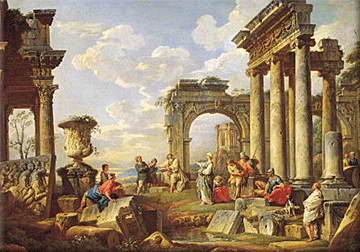-Italy 1850 Roma Papal States Egyptian Revival Micro Mosaic Pendant In 18Kt Yellow Gold
An Egyptian revival pendant brooch.
Fantastic piece, created in Roma Italy during the Papal States period, back in the 1850. This piece is really incredible detailed and was carefully crafted with Egyptian revival patterns, in solid rich yellow gold of 18 karats. It is embellished with several panels decorated with intricate micro mosaics depicting an Egyptian Pharaoh. Accented with patterns of dots and twisted tiny wires, geometrically placed.
The micro mosaic panels are Italian also, surely created in Venice during the same period from more than 800 microscopic pieces, carved from natural stones, such as; blue lapis lazuli, red jasper, black onyx, green malachite, black onyx, lava, creme nacre and 24k gold. This is piece of art, composed by elements from several artistic movements, carefully mixed together during the grand tour era, such the Victorian, the Etruscan and the Egyptian revivals.
Weight: 21.60 Grams, (13.85 Dwt).
Measurements: 42 mm by 60 mm (1.65 x 2.38 Inches).
Hallmarks: Stamped with the old Papal States assay marks for the 18kt gold. One time with the Crossed Keys and a Cardinal Capello inside a triangle and one time with the maker's lozenge cartouche with the number 16 for the Roman identification goldsmith.
History of the Hallmark: The first statutes of the guild of Roman goldsmiths date back to 1358, in which was stated the rule of the warranty punch. The University of Goldsmiths was founded in 1508 and the statutes approved the following year introduced the use of the master's mark in addition to the previous guarantee mark. In 1738, with the reform of the Statutes of Goldsmiths, the guild acquired the name of "Nobil Collegio degli Orefici ed Argentieri di Roma" (Noble College of Goldsmiths and silversmiths of Rome). The warranty mark used prior to the French invasion was a series of "crossed keys of St. Peter under a liturgical umbrella" enclosed into shields, ovals or other geometric shapes.

Note: It was in 1870, the conquest of Rome marked the end of Stato Pontificio (Papal State). Italy attained its unity along with a unique system of hallmarking, introduced in the Regno d'Italia (Kingdom of Italy).
History Behind This Piece
Between the 1820 and 1890, ancient cities were discovered, such as Troy, Pompeii and Alexandria. Archaeological excavations in Egypt, Greece and Rome, discovered artistic pieces of these ancient cultures. These fabulous discoveries, stimulated cultural trips to these countries, popularly called "grand tour". Being the case that the enthusiast visitors bring back small objects, like souvenirs to be assembled into jewelry. The starting point of these trips were in the cities of Rome and Venice. this is why the craftsmen of these cities created small and interesting objects with ancient characteristics like this bracelet.

Revival jewelry: The styles from the renaissance and Middle Ages, begun in the 1850’s, The Renaissance and Egyptian revivals were joined by a classical revival of Greek and Etruscan styles to conform a new aesthetic. As a result of the construction work on the Suez Canal in the mid-1860’s and the Egyptian excavations of Auguste Mariette and the resultant exhibit of Egyptian treasures at the exposition Universelle in 1867, a fascination for all things Egyptian and ancient cultures developed.
Note: Many nineteenth-century jewelers, were inspired to create their own versions of these ancient pieces, hence “Etruscan Revival”, the most famous being the House of Castellani. Characteristics of Etruscan and Egyptian style jewelry include use of high karat gold and semi-precious stones like lapis, malachite and agates, and most distinguishingly, the use of intricate filigree and granulation.
Note: We are offering in our other listing the pair of drop earrings en suite.
Collateral: This brooch is accompanied by a presentation jewelry box.
Condition: The overall condition of this piece is excellent. Beside the little normal wear, there is no damage to the gold. All mosaic pieces are secured in the settings. This pendant brooch has been carefully inspected to guarantee the condition and authenticity.
INVENTORY REF: P020723TTEN/.5192


























